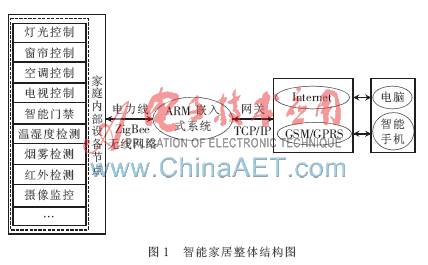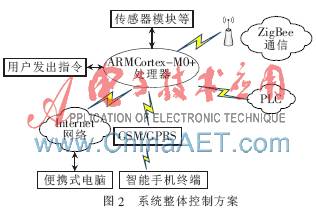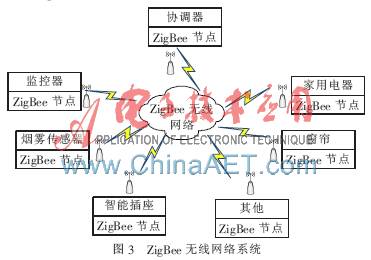Abstract: Considering the characteristics and requirements of smart homes, this study adopts a combination of wireless ZigBee sensor networks and power line communication technology. This approach not only realizes the low power consumption, low cost, and flexible networking capabilities of ZigBee, but also utilizes existing household power lines as communication channels through power line carrier technology. The combination of these two technologies achieves a complementary advantage, providing a practical solution for the construction of efficient and energy-saving home systems.
Keywords: Smart Home; ZigBee; Power Line Communication; Energy Saving
With the continuous development of GPRS remote communication technology, Ad hoc networks, and wireless network technology, as well as the increasing demands of people for their living environments, comfortable, convenient, and safe home environments have become a pursuit. The intelligentization of homes has become an inevitable trend. Currently, extensive and in-depth research and construction of smart homes are being conducted both domestically and internationally [1-7]. Among them, reference [1] proposes a ZigBee-based intelligent self-adjusting sensor to address the trade-off between device performance and power consumption in smart homes, and experimental results show that this system has good energy-saving effects. ZigBee communication technology features low power consumption, low data rates, and low-cost bidirectional communication, mainly used for data transmission applications among various electronic devices with short distances, low power consumption, and not high transmission rates [3]. Power Line Communication (PLC) is a unique communication method of the power system that uses existing power lines to transmit analog or digital signals at high speed through carrier waves. The power line carrier technology has its own limitations, such as the blocking effect of distribution transformers on power line carrier signals, the different losses of power line carrier signals due to various coupling methods, and the inherent pulse interference on the power line that significantly reduces the signal quality [7]. However, power line carrier technology has better scalability, higher reliability, and better anti-interference capabilities, which cannot be replaced by ZigBee technology. Additionally, since power lines are installed within walls, the hardware is relatively safer and less prone to damage [8]. Based on the different characteristics of ZigBee technology and power line communication technology, and considering the energy-saving needs of smart homes, this paper applies both technologies in the smart home system, achieving complementary advantages and providing a practical solution for the construction of efficient and energy-saving home systems.
1 Overall System Design
1.1 Composition of the Smart Home System
The smart home system mainly consists of four parts: touch screen control, gateway, ZigBee wireless network, and power line communication. Among them, the touch screen control is the main control part and the core of the entire system, used for sending control information and displaying information in the home system. The gateway is used to relay information between the touch screen control and the wireless network. ZigBee wireless network and power line communication are responsible for sending device information and transmitting control information to various devices; the information is sent through ZigBee nodes connected to the touch screen control module and the power line. The touch screen control module adopts an ARM embedded system, divided into hardware and software platforms. The hardware platform is composed of an ARM Cortex-M0+ processor and peripheral devices, responsible for various data calculations and GUI processing, while the software platform consists of an embedded Linux operating system and application software. The overall structure of the smart home system is shown in Figure 1. This system can conveniently control lighting, curtains, household appliances, as well as smoke, infrared detection, and video monitoring [9].

1.2 System Control Module
The smart home controller is the core of the entire system, responsible for managing, controlling, and communicating with external networks. It executes corresponding appliance management control functions based on user touch screen operation commands, can activate the alarm system when necessary, and send alarm messages to users and the security room via GSM/GPRS, as well as connect various communication interfaces required by users to achieve convenient and quick communication in smart homes. The system control scheme is shown in Figure 2.

This controller uses the ARM Cortex-M0+ as the processor, which is currently the most energy-efficient ARM processor. It is built on the foundation of the highly successful ARM Cortex-M0 processor, maintaining compatibility with its complete instruction set and tools while further reducing energy consumption and improving performance. It features an optimized two-stage core pipeline architecture, allowing the Cortex-M0+ processor to achieve energy consumption of only 11.2 μW/MHz (90 LP process, minimum configuration), while performance increases to 1.77 CoreMark/MHz, making it particularly suitable for smart home systems.
1.3 Gateway
The gateway is used to relay information between the touch screen control part and the ZigBee wireless network and PLC part. Since the main control chip ARM Cortex-M0+ processor does not implement the ZigBee protocol functionality, it is necessary to implement gateway functionality in the system to communicate with ZigBee devices. Considering that serial ports are easy to operate and have simple protocols, the gateway interface uses a serial port for connection.
2 ZigBee Wireless Network Technology
2.1 Hardware Selection
This system uses TI’s CC2530 chip, which is a true system-on-chip solution for 2.4 GHz, ZigBee, and RF4CE applications, capable of establishing powerful network nodes at a very low cost. The CC2530 combines a leading RF transceiver, enhanced 8051 CPU, programmable flash memory, 8 KB RAM, and many other features. The peripherals include rich interfaces such as general-purpose I/O ports, A/D conversion interfaces, SPI ports, and serial ports, equipped with a high-performance RF transceiver. The ZigBee wireless network mainly consists of coordinators, routers, smart terminals, and remote controls, as shown in Figure 3.

2.2 ZigBee Network Design
The network is designed using a tree-cluster topology [9]. This type of networking allows devices to save power; when the network is idle, the processor enters sleep mode, thus extending battery life [9]. The coordinator is the center of the entire network, and the main controller belongs to this type of node. The router is mainly used for receiving and forwarding data. The terminal refers to lighting, doors, windows, and various smart home appliances in the household. The ZigBee wireless network is used to send device information and transmit control information to various devices, with all information being sent through ZigBee nodes connected to the touch screen control module. The main program flowchart for ZigBee wireless network technology is shown in Figure 4.

3 PLC Technology
The greatest feature of PLC technology is that it does not require the establishment of a new network; as long as there are power lines, data transmission can occur, making it very convenient for smart home communication. By connecting a series of household appliances such as lighting, telephones, televisions, and air conditioners through power lines, PLC enables communication and control between intelligent devices, in conjunction with sensors, detectors, smartphones, and some devices that are inconvenient to connect to power lines in the ZigBee wireless network, achieving home intelligence.
3.1 Power Line Carrier Communication Module Design
The MAX2991 power line carrier chip is selected, which is a high-performance integrated chip that can effectively reduce overall system costs. The MAX2991 is designed as a power line communication analog front end (AFE) for transmitting OFDM modulated signals over power lines. The MAX2991 transceiver provides two main channels: the transmit (TX) path and the receive (RX) path. The transmit path injects the OFDM modulated signal into AC or DC lines, while the receive path is used for signal amplification, filtering, and digitizing the received signal. Together with the MAX2990 PLC baseband modem, it offers the most cost-effective data communication solution for power line networks currently available on the market. The hardware block diagram of the PLC system module is shown in Figure 5.

4 System Software
This system adopts the Linux operating system because the Linux kernel is a free and open-source operating system designed with a modular architecture, known for its flexibility and efficiency. It supports character and graphical interfaces, multiple users, multitasking, and multithreading, ensuring that users do not affect each other. Redundant functional modules have been removed to reduce code size and system latency, and necessary low-level drivers have been written. Moreover, the Linux operating system supports Internet protocols and other communication protocols, eliminating the need for additional protocol converters. The system software flow is shown in Figure 7.

This paper comprehensively considers the advantages and disadvantages of applying ZigBee and PLC technologies in smart homes, applying both technologies in the smart home system. Through the main controller, real-time and effective control of smart appliances can be achieved. This scheme realizes the complementary advantages of both technologies, achieving the characteristics of ZigBee’s low power consumption, low cost, and flexible networking capabilities, while avoiding the cumbersome wiring process of using traditional smart home data lines separated from power lines. It also provides great convenience for transforming old residences into smart homes, fully reflecting the energy-saving and emission-reduction purpose of smart homes. Therefore, the smart home solution based on ZigBee and PLC technologies has certain practical significance and research value.
With the increasing application of the IEC61850 standard in smart grids becoming a research hotspot, it is believed that the IEC61850 standard will eventually be applied to smart home systems, achieving standardization, intelligence, and consistency of communication protocols for the entire smart grid.
References
[1] BYUN J, JEON B, NOH J, et al. An intelligent self-adjusting sensor for smart home services based on ZigBee communications[J]. IEEE Transactions on Consumer Electronics, 2012, 58(3): 794-802.
[2] HAN D M, LIM J H. Smart home energy management system using IEEE 802.15.4 and ZigBee[J]. IEEE Transactions on Consumer Electronics, 2010, 56(3): 1403-1410.
[3] Luo Zhengjun, Luo Penghui, Wang Xiaojun, et al. Intelligent home system based on Linux system and ZigBee[J]. Modern Electronic Technology, 2012, 35(1): 37-39.
[4] Wang Lili, Qi Sai, Zhu Linlin. Design of an intelligent home monitoring system based on embedded Linux[J]. Electronic Design Engineering, 2012, 20(3): 92-93.
[5] Yan Ping, Zhang Xinggan, Bai Xingchao, et al. Intelligent home system based on Internet of Things technology[J]. Journal of Nanjing University (Natural Science Edition), 2012, 48(1).
[6] Dong Suge, Li Hua. Design of a smart home system based on ZigBee technology[J]. Henan Science and Technology, 2012(1): 59-60.
[7] Sun Ping, Ma Weihua. Design and implementation of an appliance control system based on power line carrier communication[J]. Microcomputer and Applications, 2012, 31: 23-26.
[8] Wang Lidong, Zhang Fengda, Mei Beizhen. Intelligent home design based on ARM and power line carrier[J]. Electronic Product World, 2012(1): 38-39.
[9] Wang Jianfeng. Research on smart home systems based on ZigBee[J]. Electronic World, 2012(1): 105-106.

